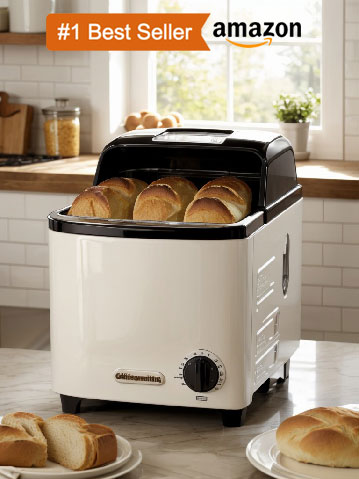Why Is My Bread Machine Bread Gummy
Bread machines have made the process of baking bread much easier, but sometimes the bread can come out gummy. This is a common problem that many bread machine users encounter. Understanding why bread can come out gummy and how to prevent it can help you to enjoy the perfect loaf of bread every time.

The amount of yeast used may be too high.
The amount of yeast used in a recipe can have a significant impact on the outcome of the finished product. If too much yeast is used, the dough will rise too quickly and produce a product that has an overly yeasty flavor. Additionally, the texture of the bread could become overly dense and gummy due to the excessive production of carbon dioxide.
To achieve the desired results, it is important to use the correct amount of yeast for the particular recipe and to follow the instructions as closely as possible. If it appears that too much yeast has been used, it may be possible to salvage the dough by letting it rise for a longer period of time before baking. However, it is important to keep in mind that letting the dough rise too long can also have negative effects and should be avoided if at all possible.
The dough may be under-kneaded.
Under-kneading dough can lead to bread with a dense texture and an overly wet consistency. Under-kneading is caused by not kneading the dough for enough time or not kneading it with enough force. The result is a dough that has not been worked sufficiently to develop the gluten proteins that give bread its structure and texture.
To prevent under-kneading, it is important to knead the dough for the recommended amount of time, usually around 10 minutes. It is also important to knead with enough force, using the palm of your hand to press down and stretch the dough. If you do not have the energy to knead the dough by hand, you can use a stand mixer with a dough hook attachment to knead the dough for you. Kneading dough properly will help ensure that your bread will have the desired texture and flavor.
See also: Oatmeal Flax Seed Sunflower Bread Machine Bread
The dough may have been allowed to rise too long.
When making bread, it is important to monitor the rising time of the dough. If the dough is allowed to rise too long, it can have a negative effect on the texture and taste of the finished product. The yeast in the dough will continue to consume the sugars and starches, causing the dough to become overly soft and gummy.
This often results in a dense and heavy texture, as well as an off flavor. In addition, an over-risen dough can make it difficult to shape and form the dough into the desired shape. Furthermore, it may cause the loaf to collapse during baking due to the weakened structure of the dough. To ensure successful results when baking bread, it is important to pay close attention to the rising time of the dough.
See also: Homemade Bread In Bread Machine With All Purpose Flour
The temperature of the liquid ingredients may be too high.
When making a recipe with liquid ingredients, it is important to make sure that the temperature of the liquid ingredients is not too high. If the temperature of the liquid ingredients is too high, it can cause the ingredients to separate, affecting the texture and flavor of the final product. Additionally, high temperatures can cause certain ingredients to burn or caramelize, resulting in a bitter taste or burnt flavor.
To ensure successful results, it is best to use liquid ingredients at room temperature or slightly cooled. Refrigerated or frozen ingredients should be thawed completely before use. Taking the time to make sure the temperature of liquid ingredients is not too high will help you achieve the desired results from your recipe.
See also: Bread Machine Mixing Spelt And Strong White Or Granary
The amount of sugar or fat used may be too high.
When it comes to food, moderation is key. Too much sugar or fat can have a serious impact on our health. Consuming too much sugar or fat can lead to serious health issues such as obesity, diabetes, and heart disease.
Sugar and fat are important sources of energy, but they should be consumed in moderation. Eating too much sugar or fat can cause us to take in more calories than we need, leading to weight gain. Additionally, too much sugar can cause an increase in blood sugar levels, which can be dangerous for people with diabetes. Similarly, consuming too much fat can lead to high cholesterol levels, which can be a risk factor for heart disease. To maintain a healthy diet, it is important to limit our intake of sugar and fat by opting for healthier alternatives when possible.
See also: How To Make Panettone In Bread Machine
The dough may contain too much liquid.
The dough may contain too much liquid if it is too sticky or wet when handled. This can be caused by the addition of too much water or other liquid ingredients, such as eggs or milk. It can also be due to the use of a low-protein flour, which absorbs more liquid than a high-protein flour.
If the dough is left to rest for too long before shaping, it can also absorb more liquid from the environment and become overly moist. To fix this, you can try adding more flour to the dough to make it more workable. Alternatively, you can reduce the amount of liquid ingredients used in the recipe or cut down on the resting time of the dough.
See also: Big Heavy Duty Baking Bread Machine Oven
The bread may not have been baked long enough.
The most likely reason that the bread hasn't turned out as expected is that it wasn't baked long enough. Baking bread correctly is a delicate process, and one of the most important steps is making sure the bread is cooked through. If the bread is not cooked long enough, it will not rise properly, it will be dense and heavy, and the crust will not be golden-brown and crispy.
Additionally, it may have a raw, doughy flavor. To avoid this issue, make sure to follow the baking instructions carefully and to check the bread for doneness before removing it from the oven. If a toothpick or cake tester inserted into the center of the loaf comes out clean, the bread is done. If not, give it more time in the oven.
The bread machine may be running at an incorrect temperature.
The bread machine may be running at an incorrect temperature if the bread is not rising properly or if it is not baking correctly. The ideal temperature for a bread machine is between 95-105°F. If the temperature is too low, the yeast will not activate and the dough will not rise.
If the temperature is too high, the yeast will become overactive and the dough will rise too quickly, resulting in an unevenly baked loaf. If you suspect that your bread machine is running at an incorrect temperature, you may want to check the manufacturer's manual for instructions on how to adjust the temperature settings. You can also try adjusting the dough's consistency by adding more liquids or adjusting the amount of flour used. Finally, you may want to try a different recipe or brand of yeast to ensure the best results.
The bread machine may not be kneading the dough properly.
A bread machine can be an invaluable tool for making delicious homemade bread. However, if it is not kneading the dough properly, the results can be disastrous. Kneading is an essential step in the bread-making process as it develops the gluten proteins that give bread its structure and texture.
Without proper kneading, the dough will not rise correctly and the bread will be dense and heavy. To check if the bread machine is not kneading correctly, it is important to observe the entire kneading cycle. The dough should become elastic and smooth, and should pull away from the sides of the bowl during the kneading process. If the dough appears too dry or lumpy, or if it does not pull away from the sides of the bowl, it may not be kneading properly. It is important to adjust the amount of liquid or flour used accordingly. Additionally, it may be necessary to increase the kneading time as some bread machines may require additional time to properly knead the dough. If these adjustments still do not yield satisfactory results, it may be time to invest in a new bread machine.
The bread machine may need to be calibrated for the ingredients used.
Calibrating a bread machine is an important step in ensuring successful and consistent results with each batch of bread. This is especially true if you are using different types of flour or other ingredients that can affect the texture, flavor, and rise of the bread. The amount of flour, liquids, and other ingredients used should be adjusted based on the type of bread you are making.
Additionally, the kneading, rising, and baking cycles should be adjusted to ensure that the bread comes out perfectly cooked. The temperature and time settings should also be calibrated for the type of bread that you are making, as well as the size of the loaf. With the proper calibration, you will be able to make delicious and perfectly cooked loaves of bread every time.





